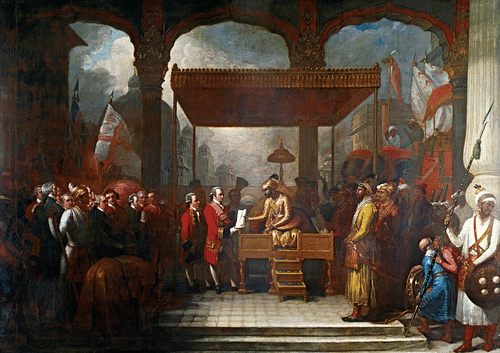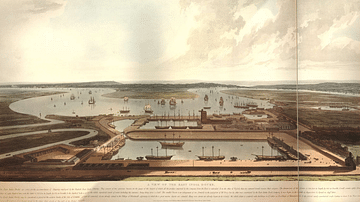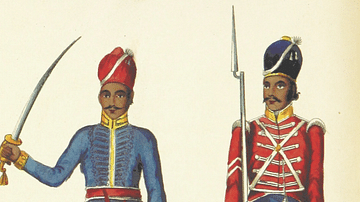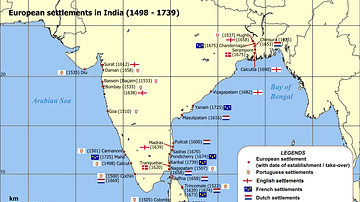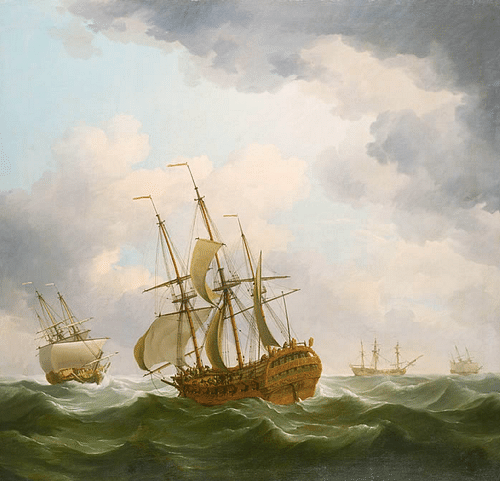
The English East India Company (EIC or EEIC), later to become the British East India Company, was founded in 1600 as a trading company. With a massive private army and the backing of the British government, the EIC looted the Indian subcontinent from 1757 until anarchy necessitated that government step in and take over EIC possessions in 1858.
The EIC was the means by which Britain conducted its imperialistic policies in Asia, and it made millions through its global trade in spices, tea, textiles, and opium. It was criticised for its monopolies, harsh trading terms, corruption, and the damage it did to the wool trade. Finally but by no means least, the EIC swept away rulers that stood in its path, relentlessly siphoned off resources, and repressed the cultural practices of the peoples living within its vast territories. In short, the EIC was the "sharp end of the British imperial stick" (Faught, 6). The EIC's directors and its shareholders gained immense riches. India, in contrast, became ever-poorer. Much more than a trading company, the EIC ultimately became a state within a state, even an empire within an empire, and one accountable to no one except its shareholders.
Foundation
A royal charter created the English East India Company on 31 December 1600 as a limited joint stock company (people invested capital and received part of the profits) managed by a group of 215 merchants and investors headed by the Earl of Cumberland. Awarded by Elizabeth I of England (r.1558-1603), the charter granted the EIC the exclusive right to trade with India, in fact, it granted a monopoly on all trade east of the Cape of Good Hope. To conduct this trade, the EIC was permitted to 'wage war'. Although the EIC did not hold sovereignty in its areas of operation, it was permitted to exercise sovereignty in the name of the English Crown and government.
The envoy of James I of England (r. 1603-1625) to the court of Jahangir, emperor of the Mughal Empire (1526-1858), was Sir Thomas Roe (1581-1644), and he built upon the first contacts made by the trader William Hawkins in 1609. Between 1612 and 1619, Roe secured permission for the EIC to set up a 'factory' or trading post at Surat on the west coast of India. The British took over the port completely in 1759, but it was replaced as the EIC's main trading centre after the English Crown acquired Bombay (Mumbai) from the Portuguese in 1661. Rulers elsewhere were induced to allow the EIC to set up more trading posts, and so the company's reach and power steadily grew. Notable new posts included Masulipatam (Machilipatnam) and Madras in 1639-40, and then Hughli in 1658. Calcutta (Kolkata) was another important EIC base from 1690.

The addition of Bombay (formally handed over to the EIC in 1668) came about because Charles II of England (r. 1660-1685) received it as a wedding gift when he married Catherine of Braganza (1638-1705) who was the daughter of John IV of Portugal (r. 1640-1656). Charles, eager to create a powerful rival to Dutch interests in Asia represented by the Dutch East India Company (VOC), gave the EIC autonomy to conduct its affairs as it saw fit. The VOC had been founded two years after the EIC, but a much greater investment in it meant it boasted a powerful naval fleet that had enabled it to take many valuable possessions of the Portuguese Empire. The VOC cornered the lucrative spice trade in Asia and its sources in Indonesia. Such was the VOC's dominance, the EIC turned its covetous gaze to India instead.
Trade
The EIC was heavily involved in what become known as the 'triangular trade', which involved exchanging precious metals for products made in India (notably fine textiles) and then selling these on in the East Indies in exchange for spices. The spices (above all pepper) were then shipped to London, where they commanded prices high enough to make a profit on the original metals investment. Later in its history, the EIC gained enormous profits from its control of the salt trade, tea trade, and sale of opium to China. The EIC imported so much tea to Britain that it switched from being an expensive commodity to a drink cheaper than locally-made beer. Helped by cheap sugar imports from slave plantations in the Caribbean, the British became a nation of tea drinkers. The trend spread to the colonies in North America, so much so that when they had to pay tax on EIC tea imports it caused the Boston Tea Party which escalated into a revolution.
To obtain tea, then only grown in China, the EIC traded opium from India. Opium was banned by the Chinese government, but the EIC smuggled it in anyway – a situation that eventually led to war between China and Britain in 1839 (The First Opium War). Other notable goods traded by the EIC included porcelain, silk, saltpetre (for gunpowder), indigo, coffee, silver, and wool. The company's ships which carried these goods across the globe were well-armed; a typical East Indiaman (the general name for an EIC ship) carried a formidable 30-36 cannons. Fortunately for the EIC, the Royal Navy was able to control much of the Indian Ocean. EIC ships were identified by their flag, first with red and white horizontal stripes and a St. George cross in the corner and then with a Union Jack after the Act of Union in 1707 that joined England with Scotland.
Such was the company's power, there were voices of protest in Britain that the EIC was drawing away too much silver from the home country's economy and its massive imports of Indian textiles were damaging to the traditional English wool trade. A response was to raise duties for cotton imports and pass laws favouring wool, such as the ruling in the last quarter of the 17th century that prohibited people in England being buried in anything other than wool clothing. Laws soon went further and banned completely imports to Britain of finished cotton cloth, but by the second half of the 18th century the material was so popular it led to the rise of a manufacturing industry. The EIC did well trading textiles around the world, but now Britain was producing its own in huge textile mills concentrated in densely populated areas such as the cities of Lancashire. In this sense, the EIC was partly responsible for this sector of the Industrial Revolution in Britain.

There was much criticism, too, that the EIC's trade monopoly was unfair and hardly in the interests of the British nation as a whole. The EIC was taken to the British courts many times by independent traders who wanted a slice of the trade with India, but the EIC cleverly argued that, strictly speaking, it had no monopoly since it had itself created the trade and not taken it over from another party. The EIC did help expand what today have become global metropolises like Mumbai, Singapore, and Guangzhou (Canton), and it created new export markets for goods manufactured in Britain and elsewhere, but the terms of the contracts the EIC imposed were never particularly advantageous to anyone but itself.
Another vast source of income came from the EIC's policy of charging rents within its territories and using without hesitation threats and violence on those who did not comply. In short, the EIC was a trading giant and, just like today's global behemoth businesses, it had friends and it had enemies, but almost always more of the latter than the former.
A State within a State
The Mughal Empire did receive some other benefits to these trade arrangements. Often British warships performed services and helped protect the interests of the emperors at sea. The British-Mughal relationship was affected by the Marathas who challenged and conquered Mughal territories in the southern and western areas of India in the 18th century. In addition, as the shape of the Indian political map shifted, from 1757, the EIC controlled its own territory and effectively became a state within a state.
The EIC invested heavily in professional military forces and paid to use regiments of British army regulars. In 1763, the EIC had 6,680 troops in Bengal alone, a figure which rocketed to 129,473 by 1823. Initially, EIC army troops and officers came from anywhere, but reforms in 1785 resulted in only Britishers holding officer rank. The majority of troops were recruited from the Indian peasantry. This vast army dwarfed the EIC's civilian employees, who numbered around 3,500 in 1830.
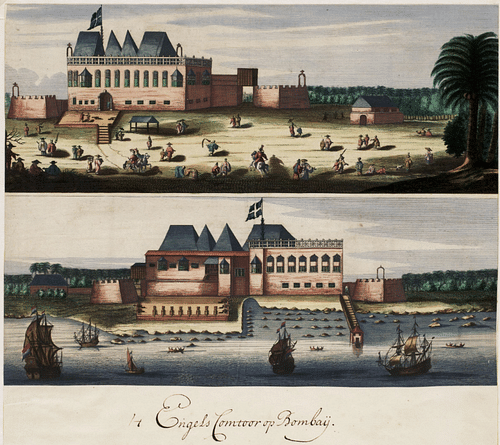
The EIC built fortresses, had a navy (the Bombay Marine), minted coinage, had a vast archive of documents (now in the British Library), ran its own courts, and maintained its prisons for those who offended against it. The company even sponsored major survey expeditions. The EIC Court of Directors chose its staff from within, and entry was through examinations, a process copied by other British institutions thereafter. Indians were excluded from the EIC. By the 18th century, the investors in the EIC (Court of Proprietors) came from all walks of life and included men, women (especially widows), nobles, politicians, military men, merchants, administrators, financiers, professionals, and small investors (including foreigners). Everybody trusted the EIC and looked forward to dividends based on its continued success.
The John Company, as it was commonly called at the time, did suffer periods of decline, especially when wars drained its resources or commerce was particularly hit by trade restrictions, corruption, smuggling, and piracy. The EIC certainly did not have everything its own way in Asia since other European powers were also keen to exploit India's trade and resources. The French East India Company (founded in 1664) boasted a well-trained army, and with the support of rival Indian rulers, it was able to challenge the EIC. Madras, for example, switched from British to French control twice. There was even rivalry from closer to home. In 1698, a second English East India Company was founded, but it merged into the older one in 1709. The new bigger company was officially called The United Company of Merchants of England trading to the East Indies, but everyone just called it the East India Company as before except in official correspondence when it was referred to as the Honourable East India Company.
Government Regulation
In 1764-5, after the Battle of Buxar, the Mughal emperor Shah Alam II awarded the EIC the right to collect land revenue (dewani) in Bengal, Bihar, and Orissa. This was a major step and ensured the company had vast resources to expand and protect its traders, bases, armies, and ships. The EIC had now become the official imperial tool of the British Empire in India, and it was the level of coordination between the various EIC centres that set it apart from both its Indian and European rivals. Men like Robert Clive (1725-1774) carved out an empire in the EIC's name. Clive of India, as he was popularly known, rose from clerk to Governor of Bengal, and his military skills, shown in such victories as the June 1757 Battle of Plassey against forces of the Nawab of Bengal, were matched by his administrative ones. Clive reduced corruption and increased regulation so that what had hitherto been private trade resembled more and more official British government control. Even so, there were still accusations that EIC officials were enriching themselves at the expense of the interests of the British state – even Clive came under suspicion. The EIC officials who retired to England and an extravagant retirement with their riches were known disparagingly as 'Nabobs', a corruption of the Mughal title for a high-ranking official, nawab.
Another, not unrelated criticism, was that the EIC was not doing enough to promote the spread of Christianity by funding churches and aiding missionaries. This was true since the company banned all missionaries until 1813. The directors were wary of making the mistakes the Portuguese Empire had made in spreading Catholicism, which alienated potential allies of other faiths. This was one of the few areas which reminded the EIC was a trading body and not a sovereign state.
Apart from religion, the interests of the EIC and the British government were becoming as one. The 1773 Regulating Act and 1774 India Act gave the British government military, financial, and political control over the territories administered in its name by the EIC. Officials of the EIC could no longer conduct private trade, and there was far more transparency over accounts and general company correspondence. The greater interest the British government began to take in India was likely a direct result of the loss of its colonies in North America in 1783.
There was now no question that the EIC was a branch of the British government, but the relationship was not one-directional. In the early 19th century, around 100 Members of Parliament in Westminster were also employees of the EIC, and so the tentacles of this trading giant reached to the very heart of political power in Britain. Warren Hastings (1732-1818) was a key figure in EIC history. Made its first Governor-General in 1774, his tenure saw the company make many treaty arrangements with independent Indian princes and replace a strategy based on conquest with one that returned to the company's roots as a trading body where administration was left to the locals. This policy was short-lived, in fact, but Hasting's tenure saw the EIC grow enormously. Hastings was considered a despot back in England, and he was put on trial for corruption but then acquitted; empire building was clearly seen as a dirty but necessary business if Britain was to compete with its European rivals.
The British-controlled territory in India kept on expanding. The Four Anglo-Mysore Wars (1767-1799) resulted in yet more territories being gobbled up by the EIC. The 1793 Bengal Permanent Settlement made tax collectors (zamindars) also landowners who now collected revenues from their tenants, which were passed on to the EIC. The idea was to make the EIC's land tax revenue more stable, but it caused a damaging upheaval in the traditional agricultural way of life and sent tens of thousands into permanent debt. This was the EIC's great conundrum: how to extract as much wealth as possible from India without causing civil unrest. It was a problem the British Empire would also struggle with when it took over, a shift that was now drawing ever closer as the EIC's days became numbered.

The Charter Act of 1813 proclaimed British sovereignty over newly-captured territory and formally ended the EIC's monopoly on trade with India. In 1819, a base was established at Singapore, which, from 1826, was administered along with Malacca and Penang on the Malay peninsula as the Straits Settlements. These acquisitions in some way masked the financial problems the EIC was experiencing after the 1825 global crash and which necessitated huge loans from the British government, loans which would lead to regulation.
Another key figure in the EIC's history now appears: Lord William Bentinck (1774-1839). Made Governor-General in 1828, Bentinck returned to the policies of the Hastings years and focussed on expansion through treaties rather than expensive military campaigns. Bentinck was also known for his social reforms and most notoriously for his abolition of sati (aka suttee) in 1829. Sati was the custom for a Hindu widow to sacrifice herself on the funeral pyre of their late husband. Other reforms included the selection of English as the company's official language (it had been Persian), but although these may have been well considered in London, in India they were rightly seen as part of an Anglicisation and Christianisation process of the subcontinent.
The 1833 and 1853 Charter Acts further reduced the EIC's powers. In 1833, the EIC lost its monopoly on trade with China. In 1853, the first railway and telegraph lines in India were put in operation. The tenure of the Marquess of Dalhousie (1812-1860), EIC Governor-General from 1848, witnessed an aggressive expansion based on military conquest of princely states where vast areas – notably the Punjab and lower Burma – were added to the EIC's property portfolio following the two Anglo-Sikh Wars (1845-1849). This hyperaggressive policy may have been successful in the short term but it backfired spectacularly.
Government Takeover
1857-58 saw the collapse of the Mughal Empire and the formal closure of the EIC as the British Crown repressed the Sepoy Mutiny (aka The Uprising or First Indian War of Independence) which rebelled against British rule. The causes of the rebellion were many and ranged from discrimination against Indian cultural practices to Indian princes not being allowed to pass on their territories to an adopted son, but the initial spark came from the sepoys. Sepoys were the Indian soldiers employed by the EIC, and they protested against (amongst other things) their much lower pay compared to British EIC soldiers. At this point, the EIC employed around 45,000 British soldiers and over 230,000 sepoys. Although the sepoys took over important centres like Delhi, their lack of overall command and coordination and the superior resources of the EIC and British government led to their downfall. After the mutiny was quashed in 1858, the British Crown took full possession of EIC territories in India and so began what is popularly termed the British Raj (rule). On 1 June 1874, Parliament formally dissolved the EIC. In 1877, Queen Victoria was proclaimed Empress of India, and British rule continued to squeeze what resources it could from India until independence was gained in 1947.
